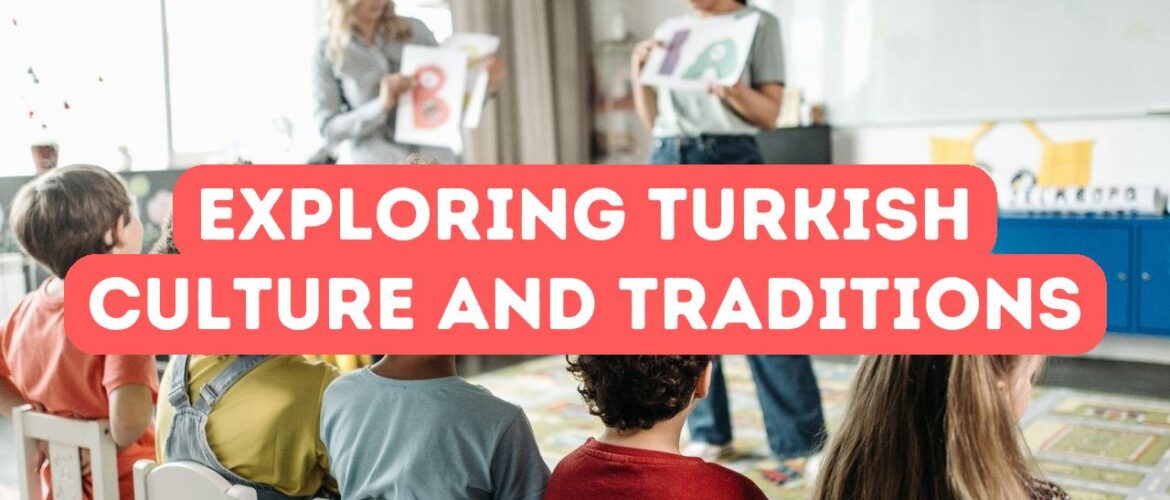Blog
Turkish Culture and Traditions Explained
- August 20, 2024
- Posted by: Burak Ünal
- Category: Turkish Education

Exploring Turkish culture and traditions offers an enriching peek into a vibrant and diverse heritage that merges the influences of the Ottoman Empire, Islamic traditions, and modern-day Turkey. From the mesmerising sounds of traditional folk music to the exquisite craftsmanship of Turkish carpets, every aspect of Turkish culture tells a unique story of history, artistry, and community. Festivals, rituals, and daily practices resonate with a deep respect for family values, hospitality, and spirituality. At Turkish Council, we understand that learning a language is more than just memorising vocabulary and grammar—it’s about immersing oneself in the cultural tapestry that gives the language life. Our Turkish Language Course for foreigners not only equips you with linguistic skills but also provides insights into the cultural nuances that define Turkey. By understanding these cultural contexts, our students gain a richer, more nuanced appreciation of the Turkish language and the vibrant traditions that go with it.
Exploring the Rich Tapestry of Turkish Cuisine
Turkish cuisine is a delightful fusion of flavors and aromas that reflect the country’s diverse cultural heritage. From the savory kebabs of Anatolia to the sweet delights of baklava and Turkish delight, each dish carries centuries of tradition and regional specialties. The meze platters, filled with a variety of appetizers like hummus, baba ghanoush, and ezme, encourage communal dining and embody the spirit of Turkish hospitality. Rich, aromatic spices such as cumin, sumac, and paprika infuse the dishes with a distinctive character, creating a vibrant tapestry that pleases the senses. Whether it’s the comfort of a homemade lentil soup or the elegance of an Ottoman-inspired feast, Turkish cuisine offers something for every palate, inviting you to savor the intricate stories behind each bite.
One of the most cherished aspects of Turkish cuisine is the ritual of tea and coffee. Turkish tea, served in delicate tulip-shaped glasses, is a symbol of friendship and hospitality, always offered to guests as a gesture of warmth and welcome. The brewing process itself is an art form, ensuring the perfect balance of flavor and aroma. Equally important is Turkish coffee, an age-old tradition deeply ingrained in the social fabric of daily life. Served in small, intricately designed cups, it is often accompanied by a piece of Turkish delight or a sweet treat. The preparation and serving of Turkish coffee is a meticulous process, from the careful grinding of beans to the slow brewing in a cezve, which results in a rich, velvety coffee that is an experience in itself. Engaging in these customs not only allows one to enjoy the unique flavors but also to participate in the time-honored practices that define Turkish communal life.
Street food is another integral part of Turkish culinary culture, offering an array of tempting treats that reflect the heart and soul of the country’s bustling urban life. From the ubiquitous simit, a sesame-encrusted bread ring perfect for a quick snack, to the juicy and flavorful dürüm, a wrap filled with spiced grilled meat and fresh vegetables, street vendors provide a rich tapestry of flavors accessible to everyone. The tantalizing aroma of roasted chestnuts and the sweet allure of lokma, deep-fried dough balls soaked in syrup, fill the air at every corner, inviting you to indulge in these simple yet beloved pleasures. Street food not only satisfies the palate but also offers an authentic glimpse into daily Turkish life, with recipes and techniques passed down through generations, making each bite a journey through time and tradition.
A Journey Through Turkey’s Festive Celebrations
Turkey’s festive calendar is a colorful blend of joyous national holidays and deeply-rooted religious celebrations, each offering a unique glimpse into the nation’s soul. One of the most prominent festivals is the traditional Kurban Bayramı, or Eid al-Adha, which underscores the importance of sacrifice and generosity in Turkish culture. Families gather to share meals, distribute food to the less fortunate, and strengthen communal bonds during this sacred time. Conversely, Republic Day, celebrated on October 29th, marks Turkey’s transformation into a modern republic, heralded by parades, concerts, and fireworks. Festivals such as these not only reflect Turkey’s rich historical tapestry but also its evolving identity, providing an immersive experience for anyone willing to delve into the heart of Turkish tradition.
Another significant celebration in Turkey is Ramazan Bayramı, also known as Eid al-Fitr, marking the end of the holy month of Ramadan. This three-day festival is filled with a spirit of joy, gratitude, and community as people break their fasts and indulge in elaborate feasts. Houses are cleaned and decorated, new clothes are worn, and families visit the graves of loved ones to offer prayers. Children often receive gifts and sweets, emphasizing the festival’s focus on renewal and generosity. Streets come alive with revelry, as friends and neighbors exchange well-wishes and delicious traditional treats like baklava and Turkish delight. Ramazan Bayramı beautifully illustrates the essence of Turkish hospitality and the deep sense of connection that permeates the entire culture.
Among the plethora of vibrant celebrations, Hıdırellez stands out as a unique spring festival that traces its origins back to ancient Anatolian traditions. Celebrated on May 5th and 6th, Hıdırellez heralds the arrival of spring and is steeped in rituals symbolizing hope, renewal, and prosperity. People from different regions gather to participate in various activities like jumping over bonfires, writing wishes on paper, and attaching them to roses or setting them afloat on rivers and streams. Music, dance, and the sharing of traditional foods such as lamb dishes and various pastries add to the festive atmosphere. This festival offers a profound connection to nature and agriculture, reflecting the enduring bond between the Turkish people and their land. Hıdırellez not only enriches Turkey’s cultural calendar but also deepens one’s understanding of the spirit and resilience embedded in Turkish traditions.
Unraveling the Mysteries of Turkish Arts and Crafts
Turkish arts and crafts are a dazzling testament to the creative spirit and historical richness of the nation. From the intricate patterns of Iznik tiles adorning mosques and palaces to the vibrant colors of handwoven kilims, every piece is a canvas that narrates centuries of tradition and innovation. The art of Turkish ceramics, with its roots firmly planted in Anatolian culture, showcases an array of design motifs, blending floral, geometric, and calligraphic elements that mesmerize the beholder. Similarly, the craftsmanship of Turkish jewelry, bearing the influence of ancient Anatolian, Greek, and Ottoman styles, reveals a profound mastery of metalwork and gemstone setting. These artistic expressions are not mere artifacts but are symbolic of the cultural meld that Turkey embodies, offering a window into the soul of a civilization that has long celebrated beauty, craftsmanship, and heritage.
The tradition of Turkish carpet weaving is another quintessential facet of the nation’s artistic heritage. Revered globally for their exceptional quality and intricate designs, Turkish carpets are much more than decorative items; they are living pieces of history and culture. Each region in Turkey boasts its unique weaving techniques and patterns, with some areas favoring geometric shapes while others incorporate more floral and figural motifs. These carpets often tell stories, with symbols and colors that convey specific meanings related to the weaver’s life, environment, and beliefs. Wool, silk, and cotton are commonly used materials, resulting in a variety of textures and finishes that appeal to both functional and aesthetic senses. The timeless beauty and resilience of these carpets make them treasured heirlooms passed down through generations, embodying the intertwined narratives of artistry, tradition, and cultural identity.
Calligraphy, too, holds a revered place in Turkish arts, intertwining the beauty of script with deep spiritual and cultural significance. Inspired by Islamic traditions, Turkish calligraphers have mastered the delicate art of penning the Arabic script, transforming words into intricate patterns and visually captivating forms. Whether inscribed on walls, in sacred texts like the Quran, or on everyday objects, calligraphy in Turkey is more than an art form—it is an act of devotion and a celebration of the divine. The elegant curves and flourishes of Turkish calligraphy are meticulously crafted, each stroke reflecting the artist’s skill and reverence. By learning Turkish through the Turkish Council, students gain unique access to understanding the cultural contexts and meanings embedded in these artistic expressions, deepening their appreciation for Turkey’s rich artistic heritage.
- Buy Our Online Turkish Language for Beginners: https://courses.turkishcouncil.org/courses/learn-turkish-a1/
- Visit Turkish Council for Turkish Course Visa Invitation Letter: https://www.turkishcouncil.org
- Visit Turkey Residence Agency for Your Immigration Requests: https://www.residentturkey.com
- Visit Gordion Partners for Investment in Turkey: https://www.investment.com.tr
- Visitez Campus Turquie si vous parlez français: https://www.campusturquie.org
Disclaimer: This article is for general informational purposes only and you are strongly advised to consult a professional to evaluate your education. No liability is accepted that may arise from the use of the information in this article.
